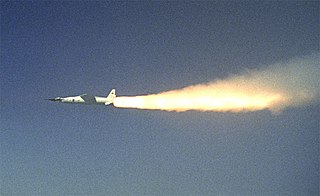Hyperspeed is a 1991 videogame.
Hyperspeed or variations may also refer to:
- Hyper Speed GranDoll , 1997 original animation video
- Hypersonic speed
- Hyperspeed glitch, a videogame term
Hyperspeed is a 1991 videogame.
Hyperspeed or variations may also refer to:

In aerodynamics, a hypersonic speed is one that exceeds five times the speed of sound, often stated as starting at speeds of Mach 5 and above.

A scramjet is a variant of a ramjet airbreathing jet engine in which combustion takes place in supersonic airflow. As in ramjets, a scramjet relies on high vehicle speed to compress the incoming air forcefully before combustion, but where as a ramjet decelerates the air to subsonic velocities before combustion using shock cones, a scramjet has no shock cone and slows the airflow using shockwaves produced by its ignition source in place of a shock cone. This allows the scramjet to operate efficiently at extremely high speeds.

The NASA X-43 was an experimental unmanned hypersonic aircraft with multiple planned scale variations meant to test various aspects of hypersonic flight. It was part of the X-plane series and specifically of NASA's Hyper-X program developed in the late 1990s. It set several airspeed records for jet aircraft. The X-43 is the fastest jet-powered aircraft on record at approximately Mach 9.6.
Mach 5 or variation, may refer to:
Super Speed or variations may refer to:

The DARPA FALCON Project was a two-part joint project between the Defense Advanced Research Projects Agency (DARPA) and the United States Air Force (USAF) and is part of Prompt Global Strike. The first part of the project aimed to develop a Small Launch System (SLS) capable of accelerating hypersonic gliding weapons as well as launching small satellites into Earth orbit. The second part of the project aimed to develop Hypersonic Weapon Systems (HWS): a short term high performance hypersonic gliding weapon previously named the X-41 Common Aero Vehicle (CAV) that could be launched from Expendable Launch Vehicles (ELV), Reusable Launch Vehicles (RLVs), Hypersonic Cruise Vehicles (HCV), or Space Maneuvering Vehicles (SMP), and a long term hypersonic cruise aircraft named the Hypersonic Cruise Vehicle (HCV). This two-part program was announced in 2003 and continued into 2006.

The Boeing X-51 Waverider is an unmanned research scramjet experimental aircraft for hypersonic flight at Mach 5 and an altitude of 70,000 feet (21,000 m). The aircraft was designated X-51 in 2005. It completed its first powered hypersonic flight on 26 May 2010. After two unsuccessful test flights, the X-51 completed a flight of over six minutes and reached speeds of over Mach 5 for 210 seconds on 1 May 2013 for the longest duration powered hypersonic flight.
Scramjet programs refers to research and testing programs for the development of supersonic combustion ramjets, known as scramjets. This list provides a short overview of national and international collaborations, and civilian and military programs. The USA, Russia, India, and China (2014), have succeeded at developing scramjet technologies.
Hypersonic speeds are highly supersonic.

Hypersonic flight is flight through the atmosphere below altitudes of about 90 km at speeds greater than Mach 5, a speed where dissociation of air begins to become significant and high heat loads exist. Speeds over Mach 25 have been achieved below the thermosphere as of 2020.
Sonic or Sonics may refer to:

SpaceLiner is a concept for a suborbital, hypersonic, winged passenger supersonic transport, conceived at the German Aerospace Center in 2005. In its second role the SpaceLiner is intended as a reusable launch vehicle (RLV) capable of delivering heavy payloads into orbit.
The Zero Emission Hyper Sonic Transport or ZEHST is a planned hypersonic passenger jet airliner project by the multinational aerospace conglomerate EADS and the Japanese national space agency JAXA.

The SonicStar was a proposed high-supersonic aircraft business jet designed by SonicStar SAS led by Bernard Rousset and motorized by HyperMach.

A hypersonic glide vehicle (HGV) is a type of warhead for ballistic missiles that can maneuver and glide at hypersonic speed. It is used in conjunction with ballistic missiles to significantly change their trajectories after launch. The concept of HGVs is similar to MaRVs, but HGVs are separated from their rocket boosters shortly after launch as opposed to MaRVs which can only maneuver just before the impact. Conventional ballistic missiles follow a predictable ballistic trajectory and are vulnerable to interception by the latest anti-ballistic missile (ABM) systems. The in-flight maneuverability of HGVs makes them unpredictable, allowing them to effectively evade air defenses. As of 2022, hypersonic glide vehicles are the subject of an arms race.

The Avangard is a Russian hypersonic glide vehicle (HGV) that can be carried as an MIRV payload by the UR-100UTTKh, R-36M2 and RS-28 Sarmat heavy ICBMs. It can deliver both nuclear and conventional payloads. The Avangard is reportedly capable of travelling at re-entry speeds.
Snow-speeder, snow speeder, or snowspeeder may refer to:

A hypersonic weapon is a weapon capable of travelling at hypersonic speed, defined as between 5 and 25 times the speed of sound or about 1 to 5 miles per second.
Mach 6 or variation, may refer to:

The AGM-183 ARRW is a hypersonic air-to-ground ballistic missile planned for use by the United States Air Force. Developed by Lockheed Martin, the boost-glide vehicle is propelled to a maximum speed of more than Mach 5 by a rocket motor before gliding toward its target. The program was cancelled in March 2023 after multiple failed tests. The program, however, continued despite the cancellation and was announced to still be in development following additional, undisclosed testing.